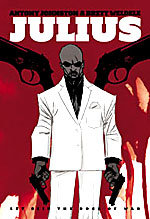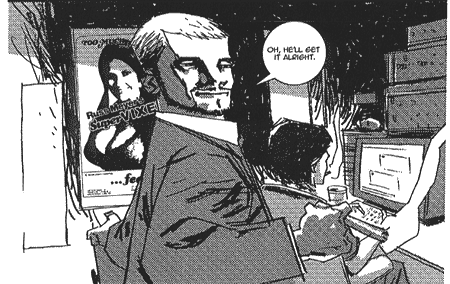 Written by Antony Johnston
Written by Antony Johnston
Art by Brett Weldele
168 pages, black and white
Published by Oni Press
I didn’t really understand Julius Caesar the first time I encountered William Shakespeare’s play. It was in 4th grade, and our teacher had our class perform an abridged version of the play. A lot of the subtleties were lost as a result, like the real nature of Julius Caesar and Brutus’s relationship, the manipulations of Cassius, or for that matter, the fact that there’s still half a play to go after Julius Caesar’s assassination. It wasn’t until much later in life that, reencountering the play, I really understood all of these things. If I’d had Antony Johnston and Brett Weldele’s Julius to read back then, mind you, I’d have learned the error of my ways much sooner.
All hail the conquering hero. Julius Cabada is a king amongst gangsters… but not literally. Well, not yet at any rate. The leaders of the different “organizations” are ready to unite under a single leader, Julius, and let him have complete control over London’s East End crime syndicates. Not everyone is ready to give up their power, though, and fearing that Julius will take what is being offered him, Cassidy is preparing to give a preemptive response to Julius. And who better to help deliver this response than one of Julius’s best friends, Brett…
The basic story of Julius is, of course, Shakespeare’s. But it’s the retelling here that is Johnston, and that’s what delighted me so much in reading it. On a large scale, the transplanting of the action into modern London worked perfectly, with the attitudes and actions taken by the conspirators a good match for what Shakespeare had originally envisioned in writing about the historic event. Soothsayers, generals, nephews who’d been sent away to make names for themselves… all of them are very much in keeping with the ideas of the original. It’s the little touches on a smaller scale, though, which really caught my eye. The technological assault on Brett with text messages, for instance, is a wonderful take on the original play, while setting the graphic novel firmly in the twenty-first century. Johnston didn’t just change “thee” to “you” and call it a day when writing the script, he really thought things through to their logical conclusion. In the end, though, the best thing about Julius is how wonderfully Johnston has captured the character of Brutus/Brett. If you ask most people what the character of Brutus is like, they’ll describe him as an evil man who hated Julius Caesar and killed him. Johnston understands how Shakespeare wrote Brutus, though; a man who was so devoted to the good of his country that he agreed to kill Caesar as an action for the good of all. Brett likewise comes across as a horribly misguided but genuine person, one whom deserves your pity, not your hatred. It’s easy to make Brutus a one-dimensional bad guy, but Julius‘s Brett is anything but that.

Weldele’s an artist with whom I’m growing more impressed with on each new project. His rough, scratchy style is well-suited to Julius‘s setting, with the characters dressed to the nines even as there’s something less-than-perfect about them. Weldele’s character designs really bring the people of Julius to life; Julius’s charisma, Brett’s inner struggle, and Cassidy’s deviousness are all on the page here, apparent at a glance thanks to Weldele’s art. Add in Weldele’s usage of grays and zip-a-tones, something which come across as a crutch for some artists but are an integral part of Weldele’s depiction of depth and texture here, and you’ve got one really attractive final product.
Julius Caesar is the sort of play that everyone knows the title, but little else. Hopefully Johnston and Weldele will be able to introduce it to a new generation in the form of Julius. In a day and age where Romeo and Juliet, Hamlet, and Macbeth seem to be the be all and end all of Shakespearian knowledge, it’s nice to see some of Shakespeare’s other classics getting their turn in the spotlight, and done so well by Johnston and Weldele. Shakespeare would be proud.
Purchase Links:
